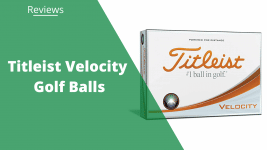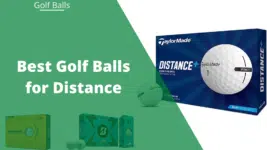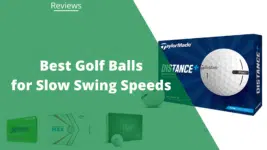As an experienced golfer, I’ve had the pleasure of testing a variety of golf balls, including Bridgestone’s popular e6 and e12 models. Both falling in the “value” category, these balls offer impressive performance at an affordable price.
Between Bridgestone e6 and e12, the e6 is a two-piece golf ball known for its softer feel, high launch, and short game spin, making it an excellent choice for beginners and those with slower swing speeds.
On the flip side, the e12 Contact is a three-piece golf ball that impresses with its medium compression rating, mid-launch, and high short-game spin, making it optimal for golfers with moderate swing speeds.
Here’s the Bridgestone e6 vs e12 verdict: The Bridgestone e6 is ideal for beginners looking for a soft feel and long distance. The e12 Contact’s multi-layer construction and innovative features make it well-rounded and better suited for slightly more advanced players.
But you will want more details because some golfers will be able to improve their game with these budget-friendly balls.
Read on for:
- Bridgestone e6 Review
- Bridgestone e12 Contact Review
- Head-to-Head Comparison — Bridgestone Golf Balls e6 vs e12
- Who Should You Play With?
- Alternatives to the e6 and e12s
Head-to-Head Comparison — Bridgestone Golf Balls e6 vs e12

Comparison Table of E6 and E12
I’ve drawn up a brief comparative table to give you a snapshot of how these two balls stack up against each other. This will help you visualize each ball’s fundamental differences and advantages at a glance.
| Key Metrics | e6 | e12 Contact |
| Construction | Two Piece | Three Piece |
| Ball Speed | Fast | Faster |
| Cover Material | Surlyn | Surlyn |
| Core Material | Large Soft Core | Gradational Core |
| Compression Rating | Low (50) | Mid (61) |
| Dimple Design | 326 Dimples | Contact Force Dimple Design |
| Launch Angle | High | Mid |
| Spin Rate | Moderate | Higher |
| Greenside Control | Good | Excellent |
| Distance | Excellent | Excellent |
| Feel | Soft | Soft |
| Price | $24+ | $29+ |
Construction: Two-Piece vs. Three-Piece
The Bridgestone E6 is a two-piece golf ball with a large inner core covered with a durable Surlyn layer, adding to its robustness and enhancing its distance capabilities. With a larger and softer core than previous models, it’s easy to compress and contributes to its excellent performance in terms of distance.
On the other hand, the Bridgestone E12 Contact is a three-piece golf ball with an innovative Active Acceleration Mantle inside its core, a characteristic designed to create faster ball speeds at impact.
The added layer results in a golf ball that provides better control and reduces side spin, making it particularly beneficial for average players.
Compression: Low vs. Slightly Higher
Compression is another distinguishing factor between these two golf balls. The E6 is a low compression ball (less than 50), which makes it easier to compress with a slower swing speed. This feature is particularly beneficial for beginner or high-handicap players, allowing them to get more distance with less effort.
The E12 Contact, however, features a slightly higher compression rating of 61. This rating makes it more suitable for golfers with moderate swing speeds, as it provides better response and overall performance.
Distance: A Comparison Off the Tee
Both the E6 and E12 Contact deliver impressive distance off the tee. The E6 has a slight advantage due to its lower compression rating and the two-piece design, which helps golfers get a few more yards on their drives.
The E12 Contact also performs admirably in this regard. Its three-piece construction and the Active Acceleration Mantle layer inside its core contribute to faster ball speeds and greater distances off the tee.
Control: Comparing Performance on Fairway and Approach Shots
When it comes to control and performance on the fairway and approach shots, the e12 Contact stands out. The three-piece construction of the e12 Contact provides more spin than the two-piece e6, resulting in better control for fairway and approach shots.
The e12 Contact also has a better holding ability on the green from a mid-iron shot, giving it an advantage over the e6.
Spin and Feel Around the Greens: A Comparison
In terms of feel around the greens, both balls offer a soft and responsive feel due to their soft cores. However, the e12 Contact edges out the e6 due to its three-piece design, which provides more spin on short shots, aiding in stopping power on the green.
The e6, while providing a very soft feel due to its low compression, doesn’t spin as much as the e12 around the greens. It might be a better fit for golfers with slow swing speeds around the green.
Durability: How Do They Hold Up?
Both the e6 and e12 Contact are durable and can withstand multiple rounds of golf without noticeable problems. The E6 might have slightly better durability, possibly because players with slower swing speeds often use it, reducing the impact on the ball.
Price Comparison: Value for Money
The e6 and e12 Contact both fall into the ‘value’ category. The e6 is cheaper, starting from $24, which could be attributed to its two-piece construction.
The e12 Contact, despite being slightly more expensive, with prices starting from $29, still offers excellent value for money due to its three-piece construction and the performance it delivers.
Recommendation for Various Swing Speeds
The E6 is designed for golfers with slower swing speeds who seek distance and a soft feel without breaking the bank.
The Bridgestone E12 Contact swing speed is best suited for slightly more advanced players, specifically those with moderate speeds between 90 and 100 mph.
Bridgestone e6 Review
Pros
- Excellent distance off the tee.
- Provides a soft feel on and around the greens.
- Good value for money.
- Easy to shape and move, providing a level of control that better players will appreciate.
- Aesthetic design with helpful alignment arrow.
Cons
- Golfers with a stronger hit may struggle for accuracy.
- While it performs well in the short game, it doesn’t offer as much spin control as multi-layer balls.
I’ve spent considerable time on the golf course and tested a variety of golf balls. One of the most enduring in my rotation is the Bridgestone e6, a ball that balances distance, soft feel, and value in an impressive package.
Performance Off the Tee — Bridgestone e6 Golf Ball Review
One of the first things I noticed about the Bridgestone e6 is its stellar performance off the tee. The ball flies long and straight, providing an excellent distance that rivals many of the top-tier balls in the market.
I found that my drives were consistently longer — thanks to the e6’s larger, softer core designed for faster compression and greater distance. Unsurprisingly, the e6 matches, if not surpasses, the driving distances of other golf balls in its category.
Mid to Long Iron Play
When I moved onto my mid to long irons, the e6 performed well. The ball’s design makes it easy to shape and move, ideal for golfers with a more nuanced game. While I noticed that my accuracy could falter when trying to hit the ball harder, the overall feel and control were exceptional.
The e6 features a thinner surlyn cover and varied dimple pattern, encouraging movement through the air, making it a valuable asset in the windier conditions I often encounter.
Performance On and Around the Green
The e6 truly shines around the greens. Despite being a distance-focused, two-piece ball, the e6 offers a soft feel that greatly assists in the short game. When putting, the ball moves smoothly and predictably, providing a measured, calm pace that inspires confidence.
Similarly, it exhibits excellent control during chips and pitches, with more stop and control than expected from a two-piece ball. The feedback and responsiveness were impressive, particularly when using a good wedge.
Aesthetics and Feel
From a visual standpoint, the e6 is quite pleasing. It features a simple alignment arrow on the side, which is useful for lining up putts or tee shots. In terms of feel, the e6 rivals the feel of more expensive balls. It’s soft yet durable, providing a satisfying balance of playability and longevity.
Bridgestone e6 Compression
When we consider the construction of the Bridgestone e6, it’s a two-piece ball designed to deliver an impressive blend of speed and control. One of its defining features is its low compression rating of 50.
This lower compression allows for a softer feel upon impact, enhancing control, especially for golfers with moderate swing speeds. Its Surlyn cover material provides a sturdy outer layer for increased durability and high launch, which assists in achieving maximum distance.
Personal Experience
The e6 golf balls, from my perspective, bring a lot to the table. They offer excellent value for money, exceptional distance, and a softer feel around the greens. The ease of Bridgestone e6 golf ball compression only enhances their appeal, particularly for mid to high handicappers.
However, the trade-off with this two-piece design is that it may not deliver the high spin performance around the greens that some golfers desire. But this trade-off may be worth it depending on your playing style and game goals.
[Click Here For More User Review]
Bridgestone e12 Contact Review
Pros
- Impressive distance off the tee due to its Contact Force dimple design.
- Provides a softer feel on and around the greens than expected.
- Available in vibrant matte color options for those who prefer a more distinctive ball.
- The design encourages straighter flight, reducing sidespin.
Cons
- The straight flight might limit workability for some players.
- Absence of alignment aids may be a minor inconvenience for some golfers.
The Bridgestone e12 Contact has significantly impacted my game due to its innovative design and impressive performance. Let’s check out the Bridgestone e12 golf balls review.
Performance Off the Tee — Bridgestone e12 Review
The Bridgestone e12 Contact provides excellent distance off the tee. Its innovative Contact Force dimple design, featuring wide, deep hexagonal dimples with raised circles, facilitates better energy transfer and straighter flights.
As a result, my drives were consistently longer, matching, if not exceeding, the distance provided by other balls in a similar category, such as the Titleist Velocity. It was clear that the e12’s unique design and three-piece construction contribute to its impressive driving performance.
Want to know about the straightest flying golf ball? We’ve got it!
Mid to Long Iron Play
When it came to mid to long iron play, the e12 Contact continued to stand out. While promoting straighter flights, its design somewhat limited the ability to shape and move the ball as much as some players might prefer.
Despite this, the control and consistency it provided were commendable. The ionomer cover of the e12 helped to provide a solid trajectory and offered adequate stopping power and control on the greens.
Performance On and Around the Green
On and around the greens, the e12 Contact surprised me. Although it’s designed primarily for straighter and longer shots, it displayed softness and responsiveness when chipping and pitching.
It provided a softer feel than I expected from a ball in its category, providing good feedback and control during the short game. When putting, the e12 offered a satisfying click off the putter face, rolling smoothly and predictably.
Aesthetics and Feel
Visually, the e12 Contact is striking and comes in a range of vibrant matte color options. It does not have an alignment arrow like some other balls, but its distinctive look compensates for this minor absence.
The feel of the ball is soft and appears to remain on the clubface slightly longer due to the increased surface contact facilitated by the dimple design.
Bridgestone e12 Compression
On the other hand, the e12 Contact is a three-piece ball, promising even greater ball speed than the e6 due to its mid-level compression rating of 60.
This higher compression results in a firm yet comfortable feel, making it ideal for golfers with a higher swing speed.
Personal Experience
From my perspective, the e12 golf balls have a lot going for them. They offer commendable distance, a pleasing feel, and are exceptionally forgiving on mishits. The focus on mid-to-higher swing speeds makes them a great choice for the average golfer.
However, they might not deliver the high-spin performance around the greens that more advanced players might seek. This is a small price to pay for the overall benefits that this ball brings to the table.
[Click Here For More User Reviews]
Who Should You Play With?
As a seasoned golfer, I can attest to the prowess of Bridgestone golf balls, particularly the e6 and e12 models. Each model has its distinctive strengths, and the choice depends greatly on the individual golfer’s playing style, strengths, and swing speed.
Let’s consider the Bridgestone e6 first. This golf ball is a distance champion, making it an excellent choice for golfers seeking to maximize their driving distance, especially those with swing speeds less than 95 mph.
It’s low compression and two-piece construction cater particularly well to mid-to-high handicappers who value a mix of distance and feel. While it lacks the advanced spin control that some seasoned golfers desire for their short game, it offers a surprisingly soft feel around the greens, a trait not commonly found in distance-focused balls.
Moving onto the Bridgestone e12, this ball is a step up in complexity and control, perfect for those golfers who can maintain swing speeds around or above 100mph.
Its three-piece construction, active acceleration mantle, and innovative Delta Wing Dimple pattern enhance off-the-tee speed and greenside performance. These features also impart an additional layer of spin control, something skilled golfers covet for their approach and short game.
Price-wise, the e12 does come at a slight premium compared to the e6, attributable to its advanced three-piece design. But for golfers who appreciate nuanced control and who possess the requisite clubhead speed to activate these attributes, the e12 provides superior value.
Why You Should Trust Us
Our team spends thousands of hours trying out and researching golf equipment to help you take your game to the next level. Here’s our product review process.
We can bring these reviews to you through the small commissions we earn if you buy through the links below.
How We Reviewed These Products
Golfspan only shares equipment and brands we trust.
I’m a PGA-certified golfer and instructor, and I thoroughly researched and evaluated the Bridgestone golf balls. Then an editor reviewed and fact-checked the review. Finally, we conduct regular content audits to update and revise our reviews to ensure you receive the latest information.
When researching this review, I considered these criteria:
- Cost
- Feel
- Distance
- Control
- Durability
Read more: The Best Golf Balls for Slow Swing Speeds
Alternatives to Consider
Golf ball choice can be a highly personal decision, influenced by many factors such as swing speed, control, accuracy, and budget. If you’re considering alternatives to the Bridgestone e6 and e12 Contact, here are some worthy competitors in a similar price and performance range.
Alternative for Bridgestone e6: Srixon Soft Feel
The Srixon Soft Feel is an excellent alternative to the Bridgestone e6. Designed for distance with a softer feel, the Srixon Soft Feel can appeal to golfers who seek similar features to the e6.
Just like the e6, the Srixon Soft Feel is a two-piece golf ball with a low-compression core. It has a soft, thin cover that promotes a softer feel and extra distance. It also features Srixon’s aerodynamic 338 Speed Dimple Pattern that reduces drag and enhances lift for maximum distance and a more stable, penetrating flight in any wind conditions
Why Choose Srixon Soft Feel Over Bridgestone e6?
The Srixon Soft Feel is especially appealing for golfers who want soft feel and long distance. Its Energetic Gradient Growth Core gives you a high-launch, low-spin trajectory off the tee for added distance and an ultra-soft feel.
Furthermore, the Soft Feel’s ionomer cover is 11% thinner and 5% softer than the previous model, with the softest feel rating tested in the low compression category.
Also, in terms of price, the Srixon Soft Feel is often comparable to or slightly lower than the e6, providing a more budget-friendly alternative while delivering excellent performance.
[Click Here For More User Reviews]
Alternative for Bridgestone e12 Contact: Callaway Supersoft
If you’re seeking an alternative to the Bridgestone e12 Contact, the Callaway Supersoft is a well-respected choice. This golf ball offers a three-piece construction similar to the e12 but with unique features that set it apart.
The Callaway Supersoft is a three-piece golf ball with a soft compression core and a durable ionomer cover, similar to the Bridgestone e12 Contact. It also features Callaway’s HEX aerodynamics, which reduces drag and promotes a stable ball flight that holds its line in the wind.
Why Choose Callaway Supersoft Over Bridgestone e12 Contact?
One key advantage of the Callaway Supersoft is its incredibly soft feel. Its low compression core promotes soft feel off the clubface and helps to maximize distance. The Supersoft is also designed to reduce spin for longer, straighter shots.
Moreover, the Supersoft has a new softer cover formulation that improves feel and control around the greens, offering a nice touch for short game shots.
Regarding pricing, the Callaway Supersoft is quite competitive and often available at a similar or slightly lower price than the e12 Contact. This makes it attractive for those looking for high performance without breaking the bank.
[Click Here For More User Reviews]
FAQs
How Do Golf Ball Layers Affect Performance?
The number of layers in a golf ball can influence its feel, distance, spin, and control. More layers often equate to more control and spin for skilled players, while fewer layers (like in two-piece balls) usually offer greater distance and durability, suitable for beginners or high-handicappers.
Does Compression Matter In A Golf Ball?
Yes, golf ball compression affects the feel and performance of the ball. Lower compression balls (like the e6) are softer and compress more easily, making them suitable for golfers with slower swing speeds. Higher compression balls are firmer and require more force to compress, often favored by golfers with faster swing speeds.
Can Golf Balls Influence My Swing Speed?
While golf balls don't directly affect your swing speed, they can influence the results of your swing. Lower compression balls are better for slower swing speeds, allowing the ball to compress and rebound effectively for maximum distance.
What Is The Significance Of Dimple Design On Golf Balls?
Dimples on a golf ball reduce air resistance, allowing the ball to travel further. Different dimple patterns can affect the ball's lift and drag, thus influencing its trajectory and stability in flight.
We’ve also got a list of the best golf balls for women.
Conclusion
Having personally tested both the Bridgestone e6 and e12 contact, I can affirmatively say that these balls cater to different golfers. If you’re a high handicapper or possess a slower swing speed, the e6 would be my definitive recommendation.
Its ability to deliver straight distance while being forgiving on off-center hits is something that you’ll appreciate on the course.
On the other hand, if you’re a mid-to-high handicapper looking for an enhanced level of control coupled with a softer feel, then the e12 Contact stands out as your optimal choice. Its advanced mantle layer and Active Acceleration Mantle technology make a notable difference in performance.
Clint is PGA-certified and was a Head Teaching Professional at one of Toronto's busiest golf academies. He was also featured on Canada's National Golf TV program, "Score Golf Canada," twice. He graduated with a degree in Golf Management from the College of the Desert in California and studied under Callaway's co-founder, Tony Manzoni.
He has a handicap index of 6.2 and spends the winters near Oaxaca, Mexico, where he plays twice a month at the Club de Golf Vista Hermosa. He's written over 100 articles at GolfSpan since 2021. You can connect with Clint at LinkedIn, FB, his website, or Clintcpga@gmail.com.
- Best score: 68
- Favorite club: Odyssey White Hot Two-Ball Center-Shafted Putter
- Favorite ball: Titleist Pro V1x
- Favorite food at the turn: Hot dog








